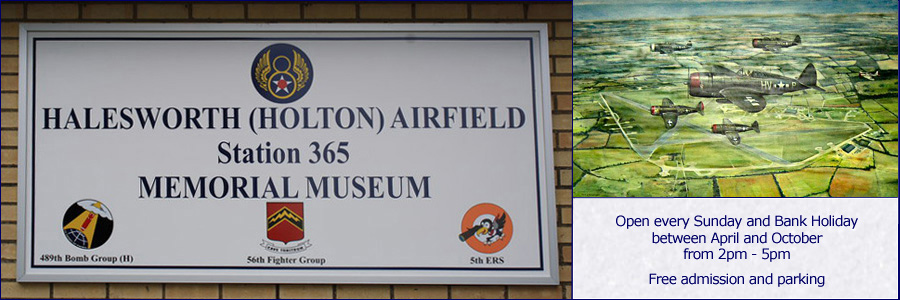The Official Newsletter of the 56th Fighter Group Memorial Association Friends of the 489th Bomb Group and 5th Emergency Rescue Squadron Friends - Spring Edition – January 2021
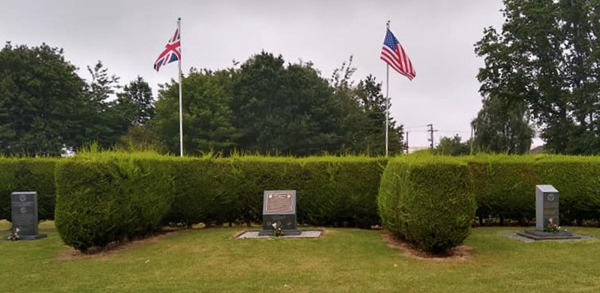 Spring is here again and we are still living under the Covid-19 virus restrictions. Due to the ongoing virus Regulations and Conditions we are still unable to open the museum to the general public. However, over the Winter our volunteers have been busy both inside and outside the museum, making good and replanting the hedge on the memorial site.
Spring is here again and we are still living under the Covid-19 virus restrictions. Due to the ongoing virus Regulations and Conditions we are still unable to open the museum to the general public. However, over the Winter our volunteers have been busy both inside and outside the museum, making good and replanting the hedge on the memorial site.
We have had no visitors of course, which is sad, because our collections inside the museum are there to be viewed and inform people of the history of the Airfield.
MEMORIAL SITE ON REMEMBRANCE DAY
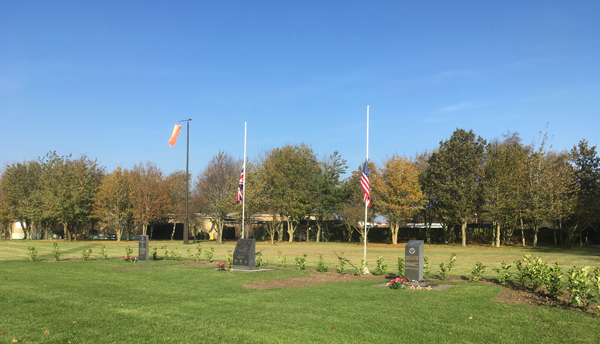 The Americans who served at Halesworth were remembered again this year.
The Americans who served at Halesworth were remembered again this year.
The photographs also show the work done by the volunteers to replace the old, tired, conifer hedge with new laurel bushes. These will grow into a fine hedge in no time. A great job done by all.
STAFF SERGEANT GEORGE PATTON, 56th FIGHTER GROUP
Just before Christmas, 56th FG veteran George and his family contacted us and kindly sent three framed pictures for the museum. These will be on display when the museum reopens, although when that will be, we don’t know yet. George is now 98 years of age and lives in Indiana. He served at both Halesworth and Boxted with the 489th on the administrative side of the 56th FG. Our thanks go to George and his family for his generous donation.
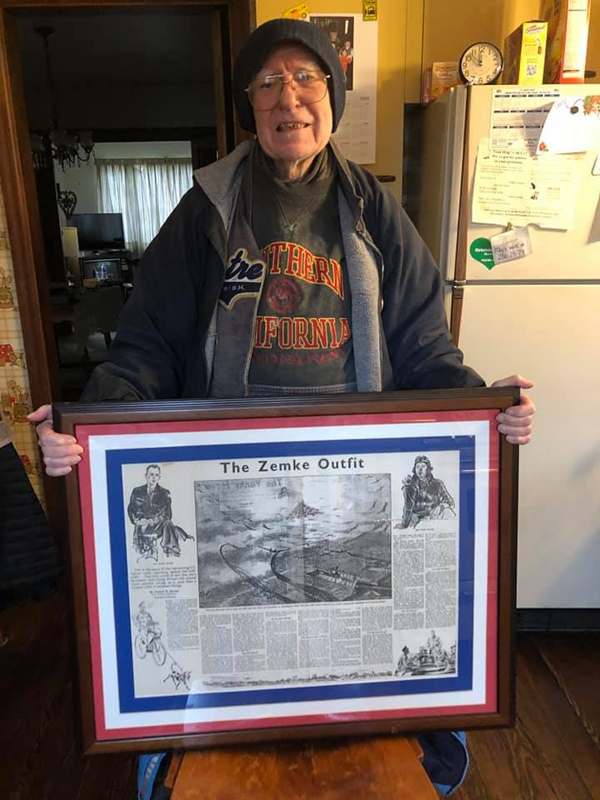
CHRISTMAS GREETINGS FROM FRIENDS
We received quite a few Christmas greetings from our American friends. It is always good to hear from them. We also received an e-card from Australian artist, Michelle Bonollo, who visited the museum some years ago. Michelle has drawn a number of our 56th Fighter Group pilots, and many of her drawings have been given to our museum archive. Richard is at present editing a booklet of these amazing drawings for inclusion in a booklet which will be on sale in the coming months.
The painting on Michell’s Christmas card is of an Australian King Parrot with roses from Michelle’s own garden.

LOOKING BACK
In 1942 the Ministry issued a schedule of airfield requirements which included:
RAF Bomber stations 80
USAAF Bomber stations 70
Bomber OTUs 54
RAF forward airfields and satellites 77
USAAF fighter stations 4
Other 115
From that date a plethora of airfields was constructed, particularly in East Anglia, one of which was Halesworth.
Airfields tended to be built on elevated level ground and if one crosses the road today opposite the museum and joins the footpath which runs down to the Bungay Road it immediately becomes clear how much the land falls away to the south.
Construction of the airfield was shared by Richard Costain Ltd and John Laing and Son with hutted accommodation for about 3000 dispersed around Holton. From July 1941 the national standard layout of airfields became one main runway 2000 yd long and two subsidiaries 1400 yd long. There were 51 dispersal sites in a mixture of frying pans and loops. In addition, there were two “T2” hangers.
The base was intended for use as a bomber station but in view of its proximity to the coast and its ideal situation for escort fighter operations the requirement was changed and it became a fighter base. In July 1943 the new airfield was christened by the arrival of the 56th Fighter Group from Horsham St Faith with Republic P47 D Thunderbolts, variously described as the “Jug” (abbreviated from Juggernaut) or the “flying Milk Bottle”. The Thunderbolt was different from contemporary fighters; it was very heavy being almost twice the weight of a Spitfire. It was very rugged and could survive heavy damage. The 56th Fighter Group was the only Group to retain P47s for the whole war.
The move from Horsham St Faith was not popular; Horsham was about to be given concrete runways and other facilities to transform it into a heavy bomber station. On arrival at Halesworth it was found that many of the domestic sites were not completed and only one of the two hangers had been constructed. Accommodation was mostly in Nissen huts, most of which were in the grounds of Holton Hall. Horsham St Faith had had brick built centrally heated barracks.
The operational squadrons were the 61st, 62nd and 63rd fighter squadrons and the first operational missions were flown before further major action was seen. The 56th escorted bombers over Europe. Hubert Zemke as group commander developed his leadership skills and it is clear from reading the excellent book “The Hub Fighter Leader” by Roger Freeman that Zemke not only stressed flight discipline and teamwork but also concentrated on the positive features of the Thunderbolt - its excellent dive performance and rate of roll. Tactics were introduced to match these advantages. By 5th November the Group was credited with 100 victories, almost double that of their nearest rivals. On 25th November the Group was engaged on its first dive-bombing operation when fifty aircraft were each loaded with 500 pound bombs and attacked St Omer airfield. On the following day they accounted for 23 kills for the loss of just one aircraft. On 30 January 1944 the 56th FG endorsed its position among USAAF groups flying from Britain by claiming its 200th victory. This total was exactly double that of the second most successful group. On 17 February 1944 one of the three squadrons, the 61st, became the first squadron to notch up 100 victories in its own right.
In mid-April 1944 the group had to vacate the airfield to make way for the green and white tailed B24 Liberators of the 489th Bomb Group. The 56th Fighter Group moved to Boxted in Essex with its reputation high having established extremely successful fighter tactics with the Thunderbolt.
The B 24Hs arrived early in May and during their stay they would operate closely with the 491st Bomb Group stationed at nearby Metfield. Together they formed the 95th Combat Bomb Wing. Metfield had been built in 1943 [more about this next time].
The 489th flew its first mission on 30 May 1944 against two aircraft depots in Northern Germany. The crews managed to escape relatively unscathed apart from one B24 which ditched in the North Sea because of fuel shortage. Eight of the crew were saved.
The Group was fully occupied and on the eve of D Day (5th June) in an attack against coastal defences near Wimereux the lead plane was crippled by enemy fire. The deputy group commander Lt Col Leon Vance Jr, who was commanding the formation, was severely wounded. His right foot was practically severed but nevertheless he continued the attack and then brought his B 24 back to the English coast where the crew bailed out. He believed a wounded man had been unable to jump so he ditched the aircraft in the English Channel. In doing so he was blown clear and his foot was severed. He clung to some wreckage and attempted to locate the injured crewman. When he realised that nobody was left he started swimming and was picked up by an air-sea rescue launch. During his stay in hospital he was awarded the Medal of Honor, the only one given to a Liberator crew man. During late July when he was being transported back to the United States the transport aircraft was lost en route.
Further missions ensued including rocket sites in the Pas de Calais, oil refineries, aircraft factories, V1 rocket sites, airfields, railways and bridges often with no losses.
On 6 August 1944 returning crews were able to attend a concert given by Glenn Miller’s band of the AEF held in the main hanger.
The final mission was in November 1944. It was intended that the 489th would be re-formed in the USA as a B 29 Superfortress unit to fight against Japan but the war ended before this could happen. By the end of November and for the month of December the airfield was virtually inactive.
In the New Year the airfield became a hive of activity starting with the 1st Gunnery and Tow Target Flight. Then, on 16 January the Air Rescue Squadron, formed to supplement the RAF’s Air Sea Rescue Service, was transferred to Halesworth to become the 5th Emergency Rescue Squadron. At the end of January, it was supplemented by the arrival of Consolidated OA-10A aircraft, known as Catalinas. These twin-engine amphibian aircraft had been designed for use by the US Navy following which RAF Coastal Command had acquired over 600. The months of February, March and April were very busy concentrating on the rescue of American and British crews and often working closely with RAF ASR units from Beccles. The last operational patrol was on 7 May 1945. It is interesting to note that in February 1945 the 496th Flying Training Squadron moved in with P-51D Mustangs and later the Fleet Air Arm flying Mosquito T3s arrived. Thus, in the last few weeks of operations from this airfield, arguably two of the most accomplished allied aircraft, the Mustang and Mosquito, flew from here. What a treat for local aircraft enthusiasts!
Paul Muttitt
FROM OUR FACEBOOK PAGE (Edited by Paul Starks)
In January Paul posted a photo of the 56th Fighter Group personnel on our Facebook page:
INSERT PHOTO > 56th FG Personnel …..
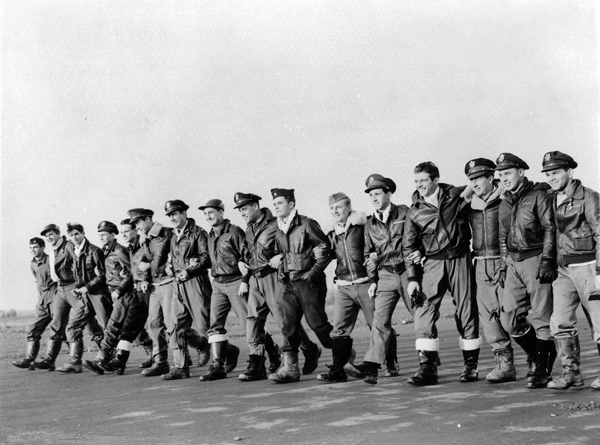
Stewart Evans provided the names for the personnel:
56th FG: Left to Right -
Capt. W. V. Cook, Cincinnati, Ohio.
Lt S. B. Morrill, Williamantle, Connecticut.
Lt J. P. Bryant, Glendale, California.
Lt. J. H. Truluck, Lynchburg, South Carolina.
Capt. Walker Mahurin, Fort Wayne, Indiana.
Lt. Harold Comstock, Fresno, California.
Lt. Col. David C. Schilling, Traverse City, Michigan.
Maj. Francis S. Gabreski, Long Island, N.Y.
Maj. M. C. Craig, Somerfield, Ohio.
Maj. J. C. Stewart, Corona, California.
F/O F. W. Klibbe, Anderson, Indiana.
Lt. J. D. Brown, Salt Lake City, Utah.
Capt. E. W. O'Neill, Long Island, N.Y.
Lt. Raymond Petty, El Paso, Texas.
Lt. I. F. Valento, Sweet Home, Texas.
Lt. A. Carcione, Bethlehem, Pennsylvania.
MISCELLANEOUS
* If you have anything you would like to share for our next Newsletter, please let us know via the museum link. Mark your subject ‘Newsletter’.
* If you would like to read further about the Groups who served on our airfield, there are several books available. Most of these can be bought from the internet, with one available for purchase on our own Museum website.
BOOKS on the 56th FG
From the ‘Fighting Units in Colour’ series:
56th Fighter Group Part 1: Kings Cliffe Kindergarten – Halesworth Heyday written by Nigel Julian and Peter Randall. Available from the Museum website here.
Out in Front: A Polish Fighter Pilot’s Dramatic Air War – Witold ‘Lanny’ Lanowski; Published by Fighting High Ltd, 2014.
BOOKS WRITTEN BY 489TH BG VETERANS
A History of the 489th Bomb Group by Charles H Freudenthal; American Spirit Graphics Corp.
Death Denied by Keith Turnham; Fairdale Publishing
In Hostile Skies – An American B-24 Pilot in World War II by James M Davis; University of North Texas Press
The Wrong Side of the Fence: a United States Army Air Corps POW in World War II by Eugene E Halmos Jr; White Mane Publishing Company.
Just An 18 Year Old During World War II by Earl Sutherland; Published by Lulu, Morrisville, NC. www.lulu.com
The Storm Clouds of War, Reflections of a World War II Bomber Pilot by Wilmer Plate; Published by Vilnius Press LLC, Portsmouth, NI.
FACEBOOK PAGE
There continues to be an incredible amount of interest in our Museum’s FACEBOOK page, mostly from our American veterans’ families. You can visit the Facebook page by clicking here.
All Newsletter correspondence to:
Halesworth Airfield Memorial Museum
Sparrowhawk Road
Upper Holton
Halesworth
IP19 8NH
www.halesworthairfieldmuseum.co.uk
email: info@halesworthairfieldmuseum.co.uk
Please note that all pictures and text within this publication are the copyright of the Halesworth Airfield Museum and must not be used, copied or distributed in any way without permission in writing from the Editor and Committee.



